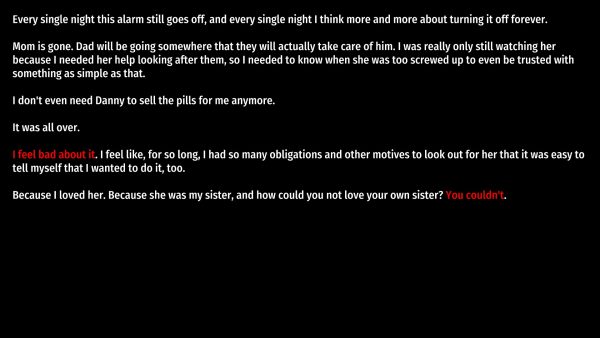
Mixed Media: Unfamiliar, Overfamiliar
April Tyack shows how Little Red Lie holds our attention hostage.
Videogames both resist and facilitate player action, and this tension affects the feeling of navigation through the material. For example, Prince of Persia (2008) was widely criticized on release for offering only minimal resistance against the player’s will to progress: missing a jump resulted in only a few seconds of downtime. As resistance is generally modeled as the loss of varying amounts of progress upon failure, Prince of Persia’s ambivalence towards player action is readable as contempt.
This model of resistance, when applied more fully, implies a false antagonism between player and game. In reality, both parties tend to agree on the terms of their dispute – commercial games, at least, prefer play-fighting over serious hostilities. In this sense, Prince of Persia simply discards the illusion that the player and game are in conflict at all – that even in opposition, game design prioritizes player enjoyment – and that realization can be unpleasant. However, videogames can offer resistance without maintaining antagonism, real or otherwise.
Little Red Lie instead resists progress by adopting formal and structural elements that prompt inefficient play behavior. In doing so, it constructs an experience like wading through mud: the state of the game environment itself suggests careful navigation, absent strictly imposed conditions of success and failure defined, detected, and measured extraneously in code. This devaluation of quantified in-game performance reflects the game’s greater interest in confronting players with a particular view of the present. Determining “success” is beyond the capacity of the software.
Like Subsurface Circular, discussed last month, Little Red Lie leans heavily on text to convey meaning throughout its examination of a near-future society wracked with economic anxiety and the resulting breakdowns of identity and interpersonal trust. The former game’s central mystery and unfamiliar societal context drive involvement in conversation; Little Red Lie instead provides two largely unlikable protagonists in a world that looks much like the present one – just much worse. As players may lack strong reasons to experience such a world through these perspectives, the text alone (regardless of its quality) is probably not enough to guarantee it will be read. Little Red Lie is similarly unconcerned with evoking the prolonged interest other commercial videogames manage with progressively complex and powerful button combinations rolled into an ever-larger katamari – no, Little Red Lie sticks to the same verbs throughout: move, begin interior monologue, and advance text.

The game alternates between the perspectives of Arthur Fox, a rich dickhead, and Sarah Stone, a middle-class liberal. Both characters face fiscal and relational crises, and Little Red Lie uses their separate narratives to clarify the effects of class background and trajectory in their attempts to recover. However, the material itself is presented plainly, and Sarah and Arthur are themselves unexceptional people in plausibly real settings. Arthur presents at a public speaking event, struggles through a TV interview, and snorts coke before a meeting with his boss. Sarah, being unemployed, “does” much less: we excavate her familial history via traversal of her parents’ house, and observe her dubious attachment to a childhood friend in a hipster coffee shop. Landmarks and local references from Scarborough, Canada – where Little Red Lie is set – are a consistent presence throughout. Although these are unlikely to be recognized by non-residents, they regardless lend the game a consistently strong sense of place. Full-screen still images are used sparingly to establish social context, reminiscent of photographs in the matter-of-factness of their presentation.
Together, these elements alter navigation of the game’s events. Past scenes are easily forgotten in the midst of reorientation to each new situation: an unfamiliar location, focused on a different character, with an indeterminate period of time since their last appearance. Each scene hence requires that players attend to the overfamiliar subject matter through inherent consideration of the unfamiliar frame.
Videogame text must fight to be read. Despite praise for a small number of “well-written” games, enshrined by the same consensus that votes Link as Best Videogame Character year after year, recent games in this tradition have been less widely well-received. To me, this suggests popular opinion is more strongly motivated by nostalgia, consensus, or insecure tastes than a sincere interest in reading. Curiously, a number of videogames either ignore the issue by making most or all narrative elements optional, or address it in the same way as action – inattention to dialogue may result in some kind of punishment. Making the failure to read closely enough a reason to lose progress (rather than access to non-critical material), however, is mostly confined to videogames where speech is a primary mode of communication and action (e.g., Amnesia: Memories, 1979 Revolution). But the trained impulse to progress as quickly as possible – to play “efficiently” – here intersects with the ease with which text is skimmed or skipped.
Little Red Lie changes the presentation of the text to discourage the instinct towards efficient play (or more specifically, “efficient reading”). Almost all such reading results from object interactions – indeed, the first thing you really understand about Little Red Lie is that pressing Z while facing a person or object will always trigger an internal monologue. Engagement hence takes a consistent form: press Z to begin monologue. The screen goes black in response. Letters appear as if typed to form a single phrase. Further input is required to see the next. And so on. Little Red Lie simply reevaluates how much text a button press is worth, complicating its navigation as a result.

Immediate legibility is further threatened by the game’s central conceit. Lies are marked with red text, and hence plainly communicate its essential meaning. Our protagonists lie to avoid thinking about uncomfortable truths: Sarah rejects her need for close relationships to justify her growing isolation, refuses to acknowledge that her feelings of superiority are a product of an undeserved class origin, and so on. Arthur simply refuses to accept responsibility for his life. However, while formatting occasionally varies, other textual elements are held constant: both protagonists monologue in a similar tone, the style itself is clear and direct, and the subject matter is familiar to anyone with even passing interest in current events. As a result, explicitly marking some text as even slightly more layered forces players to fully attend to the text without compromising accessibility. A similar-looking approach is used in some recent games (e.g., Pillars of Eternity, Pyre) that highlight text that contains further information; this helps integrate world-building into dialogue more naturally. Rather than complicating how the text is read, however, lore prompts instead suggest another place – a tool tip, a separate text box – for words to be scanned and immediately discarded from memory. Lies have inherent meaning; they can evoke curiosity where lore may not.
These elements collectively draw attention towards the game’s subject matter. The decay of a near-future society, and its human effects, are foregrounded rather than used simply as the context for the interchangeable game elements built over it. If you don’t want to think about what total failure to adapt will look like in the near future – or reflect on how possible it seems for your own life to fall apart in similar ways – there are few reasons to play it. There are no likable characters or heroes. Each individual’s fate depends on circumstance rather than self-determination. Little Red Lie presents over familiar subject matter with unfamiliar methods, which feed into each other to produce an experience that demands attention to and consideration of its unpleasant subject matter. Its design resists progress while remaining unable to measure the success of its attempt.
That videogames otherwise construct resistance via clearly defined and tested conditions for success and failure results from the medium’s stubborn claim to exceptionalism on the basis of interactivity. Videogames are (or will be) better than film – just look at how much more money they make – never mind that many studios rely on the popularity of movie tie-in games for their continued existence. More to the point, the importance of “interaction” always implies “interaction with a computer”: videogames are valuable partly because computers minimize the human requirements of play by remembering and enforcing rules, implanting images directly into the brain, and minimizing physical action. Videogames weren’t necessarily threatened by board, card, or tabletop games, but the infant medium’s basis in code was certainly seen as a direct upgrade. This overvaluation has informed a reliance on programming to solve design problems. Progress, challenge, failure – and yes, resistance – are approached with quantitative methods (e.g., using math, code, etc.), just as they dominated social science research during the latter half of the 20th century. Little Red Lie breaks from this tradition, manipulating design to resist progress through the material by forcing players to fully attend to it.
April Tyack (@stillisles) is an Australian PhD student researching videogames and wellbeing, who otherwise spends a lot of time writing papers on unrelated topics, and should probably get around to learning Unity. Her previous writing can be found at stillisles.wordpress.com.